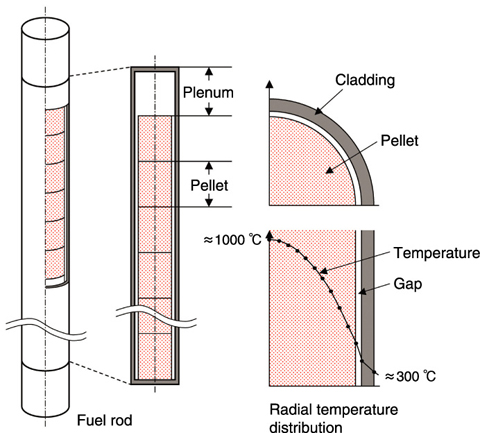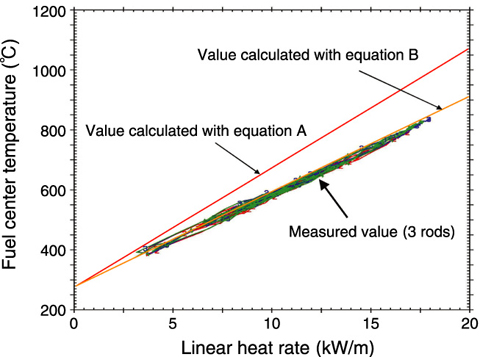
Fig.6-4 Schematic diagrams of a LWR fuel rod and radial temperature profile in the fuel rod

Fig.6-5 Comparison between measured and calculated fuel temperatures of high burnup MOX fuels
From the perspective of the effective use of resources, high burnup of LWR (Light Water Reactor) fuel and the use of plutonium (Pu) as MOX (Mixed Oxide) fuel are being promoted stepwise with LWRs.
Schematic diagrams of a LWR fuel rod are shown in Fig.6-4. Fuel behaviors such as fission gas release from pellet strongly depend on the pellet temperature during irradiation. In terms of the safety evaluation of fuel, since the fuel temperature during irradiation is strongly related to the thermal conductivity of the fuel pellet, it is necessary to evaluate the thermal conductivity of pellet with high accuracy in order to properly evaluate the pellet temperature during irradiation.
The thermal conductivities of uranium dioxide (UO2) have been investigated up to the high burnup region. However, thermal conductivity data of MOX pellet are not yet satisfactory, especially at high burnup. In this study, MOX fuels irradiated up to high burnup in European LWRs were re-irradiated in a test reactor, and data concerning the thermal conductivity change in high burnup MOX fuel (about 80 GWd/tHM) were obtained by measuring the fuel center temperatures.
The fuel center temperatures of the MOX fuel rods were measured while changing the heat generation rate per unit length of the fuel rod (Linear Heat Rate: LHR) during irradiation. The measured fuel center temperatures were compared with values calculated by a fuel performance analysis code (Fig.6-5). The thermal conductivity models of MOX pellet proposed in the literatures were used in the calculation. Equation A is an equation in which the degradation effects of Pu addition and burnup on the thermal conductivity of UO2 are considered. Equation B is an equation in which only the degradation effect of burnup on the thermal conductivity of UO2 is considered. Here, the validity of equation B with respect to UO2 pellet was confirmed by the fuel center temperature measurements of high burnup UO2 pellet that were also conducted in this study. As seen in Fig.6-5, the measured fuel center temperatures of the MOX fuel rods are close to the values calculated by equation B rather than those calculated by equation A. These results suggest that the difference of thermal conductivity between MOX and UO2 pellets becomes small in high burnup region. This also suggests that the fission products and irradiation defects accumulated in the crystal lattice during irradiation have a greater effect on the thermal conductivity of MOX fuel pellet than does the Pu added at fabrication. This information is useful for improving the accuracy of safety evaluations for high burnup MOX fuel.
The present study was performed as part of a program sponsored and organized by the Nuclear and Industrial Safety Agency (NISA), the Ministry of Economy, Trade and Industry (METI).